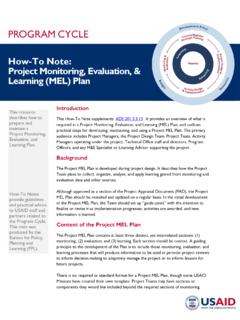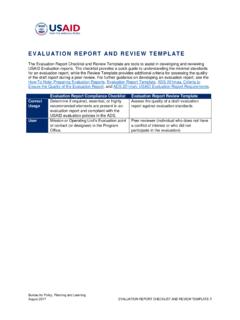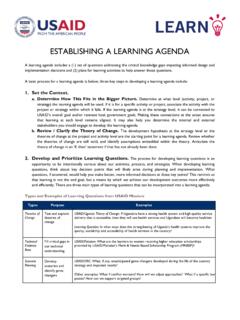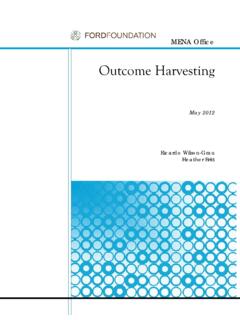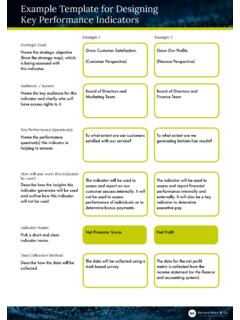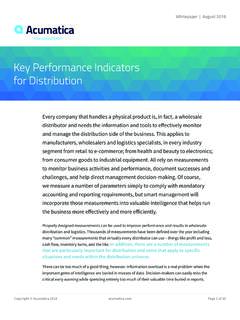Transcription of SELECTING PERFORMANCE INDICATORS - USAID Learning …
1 PROGRAM CYCLE. MONITORING. SELECTING . TOOLKIT TITLE GOES HERE. PERFORMANCE . CAN RUNINDICATORS. ON 2 LINES. Introduction This resource supplements ADS It provides an overview of PERFORMANCE indicator requirements and outlines practical steps and considerations for SELECTING PERFORMANCE INDICATORS . The primary audience includes CORs/AORs/GATRs, Project Managers, Monitoring and Evaluation Specialists, and Activity Managers. PERFORMANCE INDICATORS : The Basics WHAT IS A PERFORMANCE indicator ? An indicator is a quantifiable measure of a characteristic or condition of people, institutions, systems, or processes that may change over time. PERFORMANCE INDICATORS measure expected outputs and outcomes of strategies, projects, or activities based on a Mission's Results Framework or project or activity logic model.
2 PERFORMANCE INDICATORS are the basis for observing progress and measuring actual results compared to expected results. PERFORMANCE INDICATORS help answer the extent to which a Mission or Washington Operating Unit (OU) is progressing toward its objective(s), but alone cannot tell a Mission or Washington OU why such progress is or is not being made. While PERFORMANCE INDICATORS are not the only means of monitoring the PERFORMANCE of strategies, projects, and activities, they are an important part of such monitoring efforts. WHEN ARE PERFORMANCE INDICATORS REQUIRED IN THE USAID PROGRAM. CYCLE? PERFORMANCE INDICATORS must be included in the Country Development Cooperation Strategy (CDCS).
3 Mission PERFORMANCE Management Plan (PMP); and Activity MEL Plans. Requirements include: Program Cycle Required PERFORMANCE INDICATORS Phase Strategic Planning At least one illustrative PERFORMANCE indicator for each Intermediate Result (IR). CDCS. and each sub-IR. At least one PERFORMANCE indicator for each IR identified in the CDCS Results PMP. Framework; and At least one PERFORMANCE indicator for any Project Purpose, if identified in an approved Project Development (PDD) . Activity Design VERSION 2 | MARCH 2021 PAGE 1. SELECTING PERFORMANCE INDICATORS . Program Cycle Required PERFORMANCE INDICATORS Phase Activity MEL Plans must include at least one relevant PERFORMANCE indicator for Activity MEL Plan each activity-level outcome Reporting1.
4 At least one PERFORMANCE indicator for each IR in the CDCS. Missions can PERFORMANCE Plan and determine whether to include these INDICATORS in the PPR. Report (PPR). Applicable standard foreign assistance INDICATORS . 2. WHAT REQUIREMENTS MUST BE MET WHEN USING PERFORMANCE . INDICATORS ? Every PERFORMANCE indicator used by a USAID OU must: have a baseline;. have targets set prior to reporting data;. be disaggregated by sex when measuring person-level data; and have a PERFORMANCE indicator Reference Sheet (PIRS), complete and sufficient within three months of the start of indicator data collection. In addition, PERFORMANCE indicator data must be stored in an indicator tracking table or information system that allows quantitative analysis of indicator data.
5 A Data Quality Assessment (DQA) must be conducted for each PERFORMANCE indicator reported to external entities, including all PERFORMANCE INDICATORS reported in the PPR, at least once every three years. Further information about these requirements of PERFORMANCE INDICATORS can be found in ADS Types of PERFORMANCE INDICATORS There are several different ways to categorize PERFORMANCE INDICATORS at USAID that are useful to consider when SELECTING or developing PERFORMANCE INDICATORS for strategies, projects, and activities. OUTPUTS AND OUTCOME INDICATORS . Output INDICATORS measure what is produced as a direct result of inputs. Outputs are the tangible, immediate, and intended products or consequences of an activity within USAID 's control or influence.
6 Examples include number of health workers trained and number of bednets distributed. Outcome INDICATORS measure the condition of people, systems, or institutions that are expected to be affected by USAID interventions. Outcomes are any result higher than an output to which a given 1 In addition to the PPR, specific initiatives, sectors, or funding streams may impose additional requirements on monitoring progress with PERFORMANCE INDICATORS . 2 An indicator is applicable if the OU is expected to produce results that contribute to that indicator . Further information can be found in the annual PPR guidance. VERSION 2 | MARCH 2021 PAGE 2. SELECTING PERFORMANCE INDICATORS .
7 Output contributes, but for which it is not solely responsible. Examples include proportion of households with increased disposable income, percentage of children reading at grade level, and child mortality rates. QUANTITATIVE AND QUALITATIVE INDICATORS . Quantitative INDICATORS are based on underlying numerical data. Examples include number of teachers trained or percent of households with incomes above a poverty threshold. Qualitative INDICATORS are quantifiable, but are based on subjective criteria, such as beneficiary perceptions or expert review. One common qualitative indicator is a milestone indicator , which measures progress along a path, such as steps taken to pass a law through the legislature.
8 Another qualitative indicator is a rating scale indicator , which asks respondents to make value judgments on an ordinal scale (such as a 1 to 5 scale, where 1 equals strongly disagree and 5 equals strongly disagree ). FOREIGN ASSISTANCE INDICATORS (STANDARD OR CUSTOM). Standard foreign assistance INDICATORS are used in the annual PERFORMANCE Plan and Report (PPR) that is required of the Department of State and USAID OUs. Standard foreign assistance INDICATORS have standard definitions that enable consistent data collection across multiple OUs. A master list of standard foreign assistance INDICATORS is available at Custom INDICATORS are PERFORMANCE INDICATORS not included in the list of standard foreign assistance INDICATORS .
9 Custom INDICATORS are used for reporting in the PPR and/or for monitoring activities, projects, and strategies. These INDICATORS are identified and developed to measure achievement of results where standard foreign assistance INDICATORS are not appropriate or applicable for program management and decision-making, or where substantive changes are needed in the standard foreign assistance indicator 's definition in order to make the indicator applicable to the Mission's context. OTHER TYPES. Index (or composite) INDICATORS combine two or more data sources into a single measure. They are often used for measuring results that are multidimensional in nature.
10 Examples of commonly reported indices include the Corruption Perceptions Index and the Women's Empowerment in Agriculture Index. Proxy INDICATORS are indirect measures of a result that are linked to the result by one or more assumptions. They are often used when the most direct indicator is not practical. For example, in places where measuring household income is difficult because households engage in a variety of informal income-generating activities, household consumption is an appropriate proxy indicator for household income. VERSION 2 | MARCH 2021 PAGE 3. SELECTING PERFORMANCE INDICATORS . Gender-sensitive INDICATORS point out to what extent and in what ways development Engaging with stakeholders when SELECTING programs and projects achieved results related PERFORMANCE INDICATORS .




